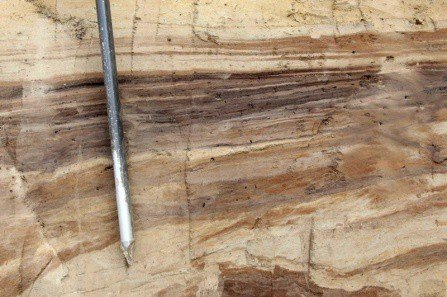In gold mines near Fairbanks, Alaska, scientists are hunting for something precious — and it’s not metal.
They’re searching through layers of ancient sediment for clues about how the region’s climate changed during periods of prehistoric global warming. The evidence is in the dirt itself, which contains chemical compounds that can reveal information about whether the region became wetter or drier as the temperature shifted in ancient times.
The ongoing project, funded by a grant from the National Geographic Society, could help researchers and policymakers understand how Alaska might respond in coming years as the planet heats up again.
It’s an urgent topic of study, as the state is already feeling the effects of climate change.
According to the 2014 National Climate Assessment, Alaska has, on average, warmed much more quickly than the rest of the U.S. in recent decades. The report finds that glaciers are melting, wildfire risks are going up and local fisheries are vulnerable to changes in ocean temperature.
“Alaska is experiencing rapid climate change right now,” says Elizabeth Thomas, PhD, the University at Buffalo geologist who’s leading the study. “By studying how the climate in this region behaved in really warm periods in the past, we can make better predictions about the future.”
“Another reason this is an interesting place to study is that regions in high latitudes are a bellwether for climate change. As they warm up, glaciers and ice sheets melt, and that impacts people around the world because it can cause sea level rise,” says Thomas, an assistant professor of geology in the UB College of Arts and Sciences.
Studying the walls of human-made canyons
The area where Thomas is working is west of Fairbanks, just south of the Arctic Circle.
This summer, she traveled there with a team that included Britta Jensen, PhD, assistant professor of earth and atmospheric sciences at the University of Alberta; Kayla Hollister, a UB geology master’s student; and Nathan Polard-Yopek, a University of Alberta master’s student in earth and atmospheric sciences.
The mines where the scientists are collecting samples are placer mines where ancient creeks once flowed, leaving behind deposits of gravels containing gold. Today, those gravels are buried under hundreds of feet of windblown silt — deposits called loess — that originate in nearby mountains when glaciers crush rock into dust.
To get to the precious metal, miners must carve deep trenches into the landscape. The walls of these canyons act as a record of prehistoric time. They hold layer upon layer of loess in beautiful Earth tones — soft grays, sandy yellows, variations of ochre — that scientists can date and analyze to learn about the region’s climate history.
“There’s been collaboration between miners and climate researchers for decades,” Thomas says. “The miners excavate these giant mounds of silt, which means we don’t have to do it ourselves. They were happy to host us. For them, the sediment is just something they’re constantly moving around, so when we asked if we could look at the walls of these mines, they would say excitedly, ‘You care about our dirt?’”
Interpreting chemical clues in dirt
Sediment from the mines holds all sorts of fascinating relics, like the remains of ancient trees and the gargantuan bones of long-dead mammoths (Hollister got to hug one).
But it’s really the dirt that’s of interest to the researchers.
During the past several million years, cyclical climate patterns driven by changes in the Earth’s orbit caused glaciers in Alaskan mountains to grow and shrink.
When glaciers were large, loess was rapidly deposited nearby in thick layers. But when the climate warmed and glaciers shrank, forests grew atop the loess. These areas would be covered up by dust again in cooler times, and so on and so forth. Today, what remains of the ancient forests are layers of rooted trees, pieces of moss, and rich, dark soil — all still found in the walls of the mines.
During the summer trip to Alaska, the research team carefully measured out sections of sediment and removed them for study.
Jensen’s lab will date samples of volcanic ash that are buried in the loess, which will provide an idea of how old different sections of sediment are. Meanwhile, Thomas and her team will analyze various compounds in the sediment to learn about the region’s prehistoric climate.
One material the researchers will investigate: Chemicals called glycerol dialkyl glycerol tetraethers (GDGTs), which are embedded in the loess. GDGTs, produced by bacteria, can be used to reconstruct prehistoric temperature trends. In a separate analysis, the scientists will examine the remnants of ancient leaf waxes, also found in the sediment. The chemical make-up of these compounds can shed light on how the region’s effective moisture — influenced by humidity and rainfall levels — fluctuated over time.
The study will cover different warm intervals that have occurred during the Pleistocene, which began about 2.6 million years ago and ended about 12,000 years ago.


